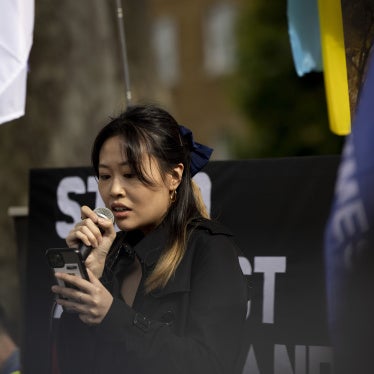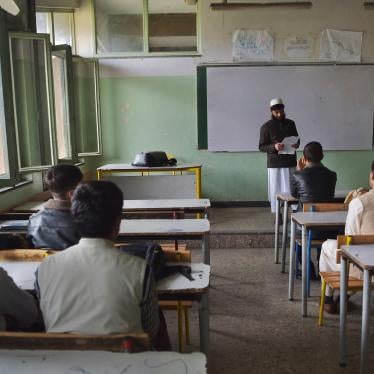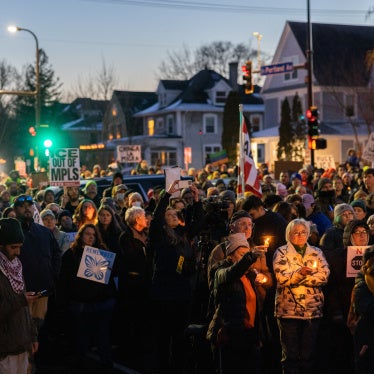H.E. Hun Sen
Prime Minister
Royal Government of Cambodia
Phnom Penh, Cambodia
March 17, 2015
Re: Human Rights Watch’s Cambodian Garment Workers Report
Dear Prime Minister Hun Sen,
We are writing in response to the public statement issued by the Ministry of Labor and Vocational Training (MOLVT) on March 13, 2015 regarding the Human Rights Watch report, “‘Work Faster or Get Out’: Labor Rights Abuses in Cambodia’s Garment Industry.”[1]
The MOLVT provided information on the number of government inspections of factories and fines imposed in 2014. We welcome more transparency around government measures to hold factories accountable. We request additional information to elaborate whether these inspections refer specifically to factories in the garment sector or to factories across sectors and the actual payment of fines. Making such information public and widely accessible is critical for monitoring labor rights and we urge Prime Minister Hun Sen to ensure regular public disclosures by MOLVT and the Ministry of Commerce (MOC) on key indicators.
In its statement, MOLVT rejected the findings of Human Rights Watch’s report. We stand by our report, for the reasons described below.
The report is based on extensive research and consultation, as described in more detail in the report’s methodology section. This includes 270 worker interviews drawn from 73 factories across 5 provinces that illustrated a pattern of problems. Our discussions with leaders from garment union federations and confederations were separate and distinct from those with workers. We referenced recent reports of independent third parties such as Better Factories Cambodia (BFC) and the International Labor Organization (ILO) when available.
We also interviewed MOLVT officials in late March 2014 and early April 2014 and cited documentary evidence provided by MOLVT in the report. In November 2014, we wrote to Minister Ith Sam Heng and Minister Sun Chanthol, requesting that they provide us any additional data to include in the report prior to publication. We received no response from the MOC. We were pleased to receive a written response from the MOLVT in December 2014 and included information from the letter in the report.
In its statement, the MOLVT wrote that it “is paying attention to strengthening the mechanisms for and effectiveness of work inspection.” We would like to reiterate our findings and concerns about the current system in order to contribute to the process of improving it.
Discrepancy Between BFC Findings and Government Enforcement Actions
We note that BFC monitors factories without any enforcement powers. MOLVT together with MOC have the responsibility to then take BFC’s findings and enforce the labor law.
Between 2009 and 2013, BFC reported that excessive overtime exceeding two hours a day (violating article 140 of the Labor Law) increased from 62 percent of 172 factories monitored[2] to 85 percent of 155 factories monitored.[3] Similarly, in 2009, BFC stated that 69 percent of 172 factories monitored were fully complying with maternity benefits.[4] By April 2013, the number had only seen marginal improvement to 75 percent of 155 factories monitored.[5]
Yet MOLVT data provided to Human Rights Watch shows that labor inspectors did not impose any fines on factories between 2009 and 2013 with the exception of 10 fines in 2011. Furthermore, the fines collected in 2011 were very low. MOLVT collected US$1247 from 10 factories, which is an average fine of $124 per factory. It is also unclear whether these amounts were calculated in accordance with Chapter XVI of the Labor Law.
Increase in Reported Inspections in 2014
There is a lack of clarity about the data provided by MOLVT in its March 13 statement regarding inspections.
In its December 2014 written response to Human Rights Watch, MOLVT stated: “The result achieved by the single work inspection teams has been that during the first eleven months of 2014 a total of 1686 inspections have been carried out, an increase of 20 per cent over before, and that arrangements were made to fine 25 factories and enterprises found to not be in compliance with the Labour Law” (emphasis added).
These numbers contrast significantly from the March 13 statement in which the MOLVT stated: “Concretely, in this past 2014, 49 all-in-one work inspection teams have carried out 7,191 inspections, imposing deadlines on 805 enterprises and facilities and imposing fines on 128 enterprises and facilities” (emphasis added).
We would appreciate a clarification of the huge jump in these numbers and the parameters being applied to these figures, as it seems logistically difficult for 5,505 inspections to have been carried out in December 2014. If all the 5,505 inspections were in fact carried out in garment factories in one month and do not include figures for factories in other sectors, we are concerned about the hurried pace and how this would severely compromise the quality of inspections unless accompanied by a significant increase in staff, budget, and other support.
Furthermore, it is important to know the monetary value of fines imposed, whether these are high enough to have a deterrent value, and whether they have been collected.
Quality of Labor Inspections and Checklist
The December 2014 MOLVT response to Human Rights Watch also stated: “The collation of a clear-cut list of questions to evaluate work conditions (Checklist) is not yet available for officials going down to do inspections. The result is that the quality and effectiveness of on-the-spot work inspection and resolution of labor disputes remains limited.”
In a positive step forward, the MOLVT began cooperating with BFC to develop a checklist in 2014. It is not clear whether the checklist has been finalized and is in use in all factories.
Budget for Labor Inspections
When Human Rights Watch met with MOLVT officials in March and April 2014, the officials said that they did not have a “program specific budget” for labor inspections. They said that the MOLVT had no information about how much money was spent on labor inspections in the past. They also said that they were not sure how much would be allocated going forward but welcomed the idea of program budgeting and developing a plan of activities.
Clear and sufficient budget allocations are important for planning and effectiveness. Public information about these allocations and expenditure is important to understand whether the government is spending enough money to ensure quality inspections in all factories.
Number of Garment and Footwear Factories
It is not clear how many garment factories there are and how many are covered by MOLVT monitoring. For example, in July 2014, the Ministry of Industry and Handicrafts reportedly stated that there are 1,200 registered garment factories but the names and addresses have not been disclosed. According to the president of the Cambodian Labor Confederation, At Thorn, MOLVT officials informed him that 1087 factories are registered with the ministry, indicating that a number of factories registered with the Ministry of Industry and Handicrafts are not on the MOLVT list. The MOLVT does not disclose the name of all factories it monitors. The MOC maintains on its website a searchable list of business registrations[6] but does not publicly disclose a list of active garment factories.
Limits of BFC Monitoring and Reporting
BFC does not include all factories in Cambodia. First, BFC is still in a process of expanding its monitoring of all factories with export licenses. A vast majority of subcontractor factories without export licenses are not monitored by BFC because it does not have the mandate to monitor these factories. Some of the worst problems we documented took place in these subcontractor factories and there should be a stronger emphasis on expanding inspections to them.
Non-Implementation of Key Government Regulations on Monitoring and Enforcement
Human Rights Watch would appreciate greater information about enforcement of government regulations with respect to labor compliance. For example, in 2005, Prime Minister Hun Sen issued a circular that enables the MOC to suspend and cancel the export licenses of factories with poor working conditions. Similarly, a 2011 government prakas (regulation) outlines a set of permissions and notifications that suppliers should follow before subcontracting. [7] The government also set up an inter-ministerial commission tasked with tracing unregistered subcontractor factories and ensuring labor compliance. Factories with export licenses subcontracting to unregistered factories can face temporary suspension of their export licenses; repeat offenders can have their licenses revoked.
Human Rights Watch wrote to the MOC in November 2014 seeking information on enforcement of the 2005 circular and the 2011 prakas. We received no response. We also wrote to the MOC seeking a meeting but the meeting has yet to be granted.
Allegations of Corruption
Corruption can erode meaningful labor law enforcement and protection of workers’ rights. Two former labor inspectors told Human Rights Watch about payments made by factory managers to government labor inspectors. Other information gathered corroborated corrupt practices that undermine labor inspection.
These findings and our recommendations are explained and supported in greater detail in the full report. We remain committed to a dialogue with the MOLVT and MOC. We hope that the ministries will take the steps needed to improve transparency and accountability and make Cambodia a model where business and labor rights can go hand in hand.
Recommendations to Prime Minister Hun Sen
-
Oversee inter-ministerial coordination and direct MOC, MOLVT, and the Ministry of Industries and Handicraft to coordinate and develop a publically accessible and updated database of all garment and footwear factories disclosing what registrations they have and which factories are inspected by MOLVT, and the last date of inspection. Invite international technical communications and technology assistance to create such a database.
-
Monitor and issue public progress reports on enforcement actions initiated by the MOC and MOLVT against low compliance factories named in the BFC Transparency Database.
-
Expand BFC’s mandate to cover subcontractor factories without export licenses.
-
Invite BFC to expand the List of Low Compliance factories on the Transparency Database to include the bottom 20 percent of factories performing poorly.
-
Invite BFC and the ILO to assess and provide feedback on MOLVT inspections and disclosure practices, with the participation of all actors, including labor rights activists and independent unions.
Recommendations for MOLVT
-
Publicly and regularly disclose (such as every four months) details about the factories inspected, key labor rights violations found, and enforcement actions taken. The terms of disclosure should be finalized in consultation with various actors, including labor rights advocates, independent unions, and BFC. For example, the disclosure should reveal the names of factories inspected, whether they are monitored by BFC, labor rights violations found if any, amount of fine imposed and whether the fine was collected. Invite international technical communications and technology assistance to create such a database.
-
Ensure adequate resources for labor inspectors in Phnom Penh and other provinces and periodically disclose a statement of allocation and expenditure, including out-of-pocket reimbursement for factory inspectors, in order to curb rent-seeking.
-
Publicly and regularly disclose what actions are undertaken as part of the 2005 circular which requires the government to follow-up on BFC reports.
-
Create and advertise a hotline for workers to report corruption by labor inspectors to the Anti-Corruption Unit.
Recommendations for MOC
-
Publicly and regularly disclose (such as every six months) the names and number of garment and footwear factories that are registered with the ministry so that these may be cross-verified by labor rights groups and MOLVT for inspections.
-
Publicly and regularly disclose (such as every four months) any actions initiated by the MOC against garment and footwear factories that are not compliant with Cambodia’s Labor Law, especially factories appearing on BFC’s Transparency Database as per 2005 circular, including threats of suspension of export licenses.
-
Publicly and regularly disclose (such as every six months) the names of all international apparel and footwear brands sourcing from Cambodia.
-
Publicly and regularly disclose (such as every six months) what actions were taken to implement the 2011 regulations on subcontracting.
Please do not hesitate to contact us for any additional information at WRD@hrw.org or by fax at +1-212-736-1300.
Yours truly,
Nisha Varia
Advocacy Director
Women’s Rights Division
Human Rights Watch
CC:
1. H.E. Sun Chanthol, Minister of Commerce
2. H.E. Ith Sam Heng, Minister of Labor and Vocational Training
[1] Human Rights Watch, Work Faster or Get Out: Labor Rights Abuses in Cambodia’s Garment Industry, March 2015, https://www.hrw.org/reports/2015/03/11/work-faster-or-get-out.
[2] BFC, 23rd Synthesis report, http://betterwork.com/cambodia/wp-content/uploads/2013/05/23rd-Synthesis-Report-en.pdf (accessed March 15, 2015), p. 7.
[3] BFC, 30th Synthesis report, http://betterfactories.org/wp-content/uploads/2013/07/30th-Synthesis-Report-Final-EN.pdf (accessed March 15), 2015), p. 11.
[4] BFC, 23rd Synthesis report.
[5] BFC, 30th Synthesis report.
[6] Ministry of Commerce, “Trade Information: Business Registrations” undated, http://www.moc.gov.kh/Company/Default.aspx?MenuID=18 (accessed March 16, 2015).
[7] Ministry of Commerce, Prakas on Subcontract Management in Garment and Textile Industry, No. 3896 MOC/SM 2011, September 5, 2011; Ministry of Labor and Vocation Training, Ministry of Commerce, and Ministry of Interior, Inter-Ministerial Prakas on Subcontract Management in Garment, Textile, and Footwear Industry, June 27, 2011,








